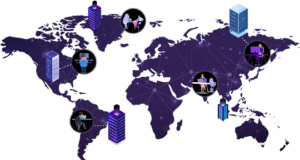Advantages and Drawbacks of Migrating to Multi-Cloud Infrastructure
Introduction#
The multi-cloud management is an innovative solution to increase business effectiveness. Because of the custom-made IT solutions on multi-cloud used by businesses for rapid deployments, it results in greater profitability. The use of multi-cloud by large and medium size organizations is based on the advantages offered by cloud computing. The competitive edge to select from the best cloud solution provider is a unique tool for business growth. The global organizations with maximum workloads gets benefitted from multi-cloud operations. The multi-cloud management offers uniqueness to business organizations and makes their operations reliable and safe. However, a business organization can also get negative impacts from technology. There are pros and cons of multi-cloud computing for organizations moving to multi-cloud infrastructure from private cloud services.

Multi-cloud Migration Pros and Cons#
Businesses always migrate from one technolgical platform to other searching profitability. Cloud based migration is enabling businesses to open up to innovative solutions. Currently, there is an on-demand scope of migrating to multi-cloud architecture. The aim is to get benefitted from the pile of IT solutions available from across the best on the cloud. Businesses are carefully selecting the most competitive cloud management considering pros and cons simultanesouly.

Benefits of Migrating to Multi-Cloud Solutions#
There are various benefits that organizations can drive from multi-cloud management elaborated below:
Rapid Innovation#
- Modern businesses migrating to multi-cloud deployment are seeking innovation at a rapid pace that results in changing branding and scalability.
- The use of multi-cloud management offers limitless solutions to business that improves customer approachability.
- Best outcomes from the selection of best services on multi-cloud gives freedom to choose from the very best.
Risk Mitigation#
- Using the multi-cloud infrastructure the businesses are given a risk-free workability that is generated through an independent copy of the application on the cloud server.
- The use of multi-cloud deployment in case of any disruption ensures that businesses on the multi-cloud computing management are working continuously.
Avoiding Vendor Lock-In#
- This is one of the greater benefits to organizations moving their business onto multi-cloud computing management. The private and public cloud services offer restricted access to the services and capabilities.
- Hence, businesses using public or private cloud services offer a lock-In that does not generate competitiveness of the services. Thus, multi-cloud management and multi-cloud providers effectively render opportunities that enable the business to switch services reducing its dependency.
Lower Latency#
- The use of multi-cloud computing is effective in transferring data from one application to another. Migration of the business to a multi-cloud management platform offers lower latency that enables the application and services to transfer their data at a rapid pace.
- This is directly connected with the application usage and its effectiveness for the user and is an advantage to the business migrating to the multi-cloud service.
Drawbacks of Migrating to Multi-Cloud Solutions#
The following are the drawbacks that businesses had to look into when migrating to the multi-cloud management platform:
Talent Management#
- with the growing conversion of business into multi-cloud computing platforms, organizations are struggling to find the right talent to operate and function effectively on the cloud systems.
- The decision to move to multi-cloud management requires skilled people who know how to work on cloud computing systems. With the increased pace of migration to multi-cloud, there is a shortage in the market for the right talent.
Increased Complexity#
Adding a multi-cloud management platform into the business results in taking in services from the multi vendors as a part of risk mitigation, but it also adds complexity to the business.
Handling various operational frameworks of software used by various vendors requires knowledge and training, a level of transparency, and technical know-how.
The cost of managing a multi-talent team comes at accost along with managing the licensing, compliance, and security of the data.
Thus, businesses migrating to multi-cloud management need to prepare a comprehensive cloud handling strategy to restrict the operational and financial dead-load.
Security Issues#
- The bitter truth is that realizes migrating to a multi-cloud management platform system is an increased risk to data safety.
- Multi-cloud services are provided by various vendors and thus create a vulnerability of IT risks.
- There is a regular issue of access control and ID verification as reported by users.
- Thus, a multi-cloud infrastructure is more difficult to handle as compared to a private cloud.
- Encryption keys and resource policies, requires multi-layer security because of different vendor accessibility.

It is evident that the use of multi-cloud infrastructure to innovate and grow the business has resulted in large-scale migration of businesses and companies across the globe. Post-pandemic work culture and business strategies also place migrating to multi-cloud as a part of future sustainability. Subsequently, there are issues in migrating to multi-cloud management and seeking multi-cloud services from various vendors. The advantages such as risk mitigation, rapid innovation, and avoiding vendor lock-in are the biggest motivation for businesses to migrate to multi-cloud as compared to the high security risks and need for expertise and its associated cost to hire and retain the talent within an organization are some of the positives. Thus, the future belongs to the multi cloud as the benefit offered are more then negatives.
If your enterprise is looking for a way to save cloud budget, do check out this video!





